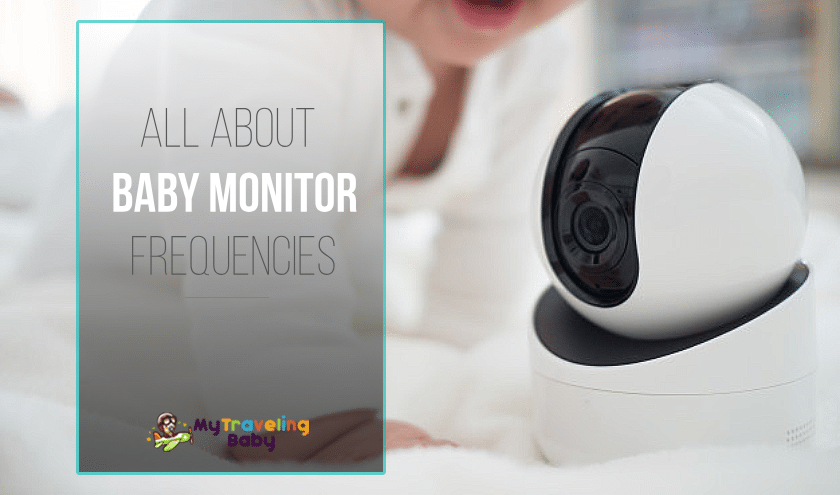
Ever since they were first used at the end of the 19th century, radio waves have become a part of everyday life.
Satellites, FM and AM radios, cell phones, and many other devices that communicate with an outside source wouldn’t work without this fantastic discovery. When it uses radio waves, a device is capable of sending and receiving messages in text, audio, and video formats, as long as it has the proper software and hardware configuration.
These devices also include baby monitors. The main reason why many parents purchase long-range baby monitors is that they let them stay in touch with their children. Thanks to radio waves, the distance between the parents and their kids ceases to be an obstacle.
In this article, we’ll provide everything you need to know about baby monitor frequencies. But before we do so, let’s have a quick look at the primary components of every good infant monitor.
Baby Monitor Components
Most of today’s baby monitors are advanced and elaborate. However, the earliest devices of this type possessed only two components. These were the receiver unit and the sender unit.
The “sender” part had a microphone, whose job was to collect the sounds coming from the baby. These sounds were then transmitted to the receiver part. A parent would have to place the sender unit into the child’s room and carry the receiver with themselves. In this way, they were able to hear if the baby is uncomfortable or hungry.
Modern devices, on the other hand, are more complex. They come equipped with two-way communication channels, with both ends being capable of sending and receiving signals. Moreover, the nature of the information that they’re capable of transmitting is much more elaborate than before.
With a modern infant monitor, a parent can hear the baby crying, but also talk back to her. This is due to the presence of a receiver gadget. The best devices of this type can also convey audio and video signals.
Some even have differently-colored bulbs – these light up in colors that correspond with the baby’s current mood. For example, if the baby is talking and seems to be happy, a green bulb will light up on the parent’s receiver unit. As you can already guess; the red bulb lights up when the child is crying or feels uncomfortable.
Modifications such as this one have proved to be quite useful. These baby monitors are especially convenient when a parent is at a noisy location, and can’t easily hear if the baby is crying.
What about Radio Frequency?
Almost all communication devices come with a design that allows collecting and converting audio, text, and voice data into electromagnetic signals. They can also receive signals of this type, and then convert them to forms identifiable to humans – video, audio, and text. The process of these waves being converted to human-identifiable forms is done by Frequency Modulators (FM) and Amplitude Modulators (AM).
In this sense, a baby monitor frequency indicates the distance that a single wave needs to cover in one second before the next wave is generated. The term “hertz”, on the other hand, refers to cycles of waves per one second – all waves travel in cycles. The frequency multiples of 1000, 1,000,000, and 1,000,000,000 are called kilohertz, megahertz, and gigahertz.
Data Transmission through Waves
When it comes to transferring data through waves, a transmitter has two options. The data transfer can occur either through the frequency differences per every second or along the wave’s amplitude. As we said, frequency is the distance between the two consecutive waves, while the amplitude represents the wave’s height.
With AM infant monitors, for example, various amplitude combinations correspond with various sound intensities understood and produced by the receiver device.
Baby Monitor Types based on Frequencies
Most baby monitors typically operate within a range of 49.3MHZ to 49.8MHZ. However, some of these devices also work in other baby monitor freq ranges such as 2.4GHz.
An essential thing to understand here is that baby monitors can be separated into different categories. These categories are based on which technology they use when receiving and transmitting signals. They can be digital, analog, AM-based, or FM-based. Let’s take a closer look:
· AM Baby Monitors
The transmitters found on AM-based devices encode signals based on the amplitudes of electromagnetic waves.
The receivers come with a design that allows them to decode signals that are conveyed in this way. AM (Amplitude Modulator) receiver will, hence, “search” for signals that are found within a wave spectrum that it can read.
An important advantage that comes with this is that AM signals are capable of traveling over significant distances. Moreover, they easily overcome barriers such as walls and come at a low price.
When it comes to downsides, security is a major concern. These devices are easy to pry on, particularly due to their decreased reading range. With amplitude modulation occurring along a single wave’s height, an external party can easily listen to conversations.
Another downside is signal interference. Two people living in the same home and using two AM infant monitors would likely bump into interference issues. There’s a pretty good chance that one AM device would pick up the signals produced by the other device. Moreover, AM receivers produce a significant amount of background noise and can sometimes be inconvenient to use.
· FM Baby Monitors
The FM receivers, on the other hand, decode messages that are sent along the frequency spectrum. Unlike in AM receivers, where the wave’s amplitude is the only thing that matters, here a single wave’s length generated per one second denotes individual information.
Due to their minimal signal interference and reduced noise, many parents opt for FM-based models. FM receivers ignore weaker signals, so there’s no way for two same FM baby monitors to interfere with one another. Moreover, their higher bandwidth allows them to incorporate video signals.
The primary downside is the distance limitation. Signals produced by FM-based models weaken with distance, with barriers like walls having a significant impact on their performance.
However, an important thing to remember here is that many models come with special switches that allow the user to switch between FM and AM transmissions easily. You won’t have to purchase two separate units, but easily enjoy the benefits of both types.
· Analog vs. Digital?
Due to their compatibility with modern, internet-based technology, digital baby monitors have become very popular in recent years. With a stable internet connection, they’re capable of synchronizing information with smartphones and personal computers. Their video and audio quality is typically much higher, and noise interference is rarely a problem.
Another advantage is that they’re less prone to hacking. To hack a digital model, it would take a lot more time and resources than to hack an analog-based baby monitor. Moreover, Wi-Fi-enabled devices allow moms to monitor their little ones even when they’re far away from home.
However, digital models are not preferable in areas with an unreliable internet connection. They are also more expensive than their analog counterparts.
Conclusion
That’s it! Hopefully, this short but comprehensive guide on baby monitor frequencies will help you select a model suitable to your needs. Good luck!




